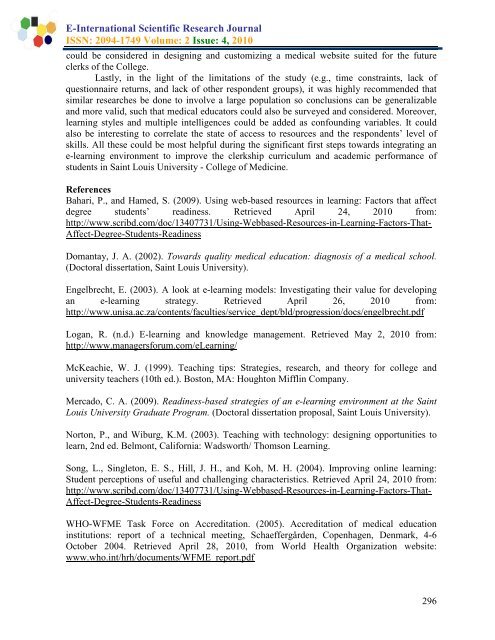download the full article here - EISRJC
download the full article here - EISRJC
download the full article here - EISRJC
You also want an ePaper? Increase the reach of your titles
YUMPU automatically turns print PDFs into web optimized ePapers that Google loves.
E-International Scientific Research JournalISSN: 2094-1749 Volume: 2 Issue: 4, 2010could be considered in designing and customizing a medical website suited for <strong>the</strong> futureclerks of <strong>the</strong> College.Lastly, in <strong>the</strong> light of <strong>the</strong> limitations of <strong>the</strong> study (e.g., time constraints, lack ofquestionnaire returns, and lack of o<strong>the</strong>r respondent groups), it was highly recommended thatsimilar researches be done to involve a large population so conclusions can be generalizableand more valid, such that medical educators could also be surveyed and considered. Moreover,learning styles and multiple intelligences could be added as confounding variables. It couldalso be interesting to correlate <strong>the</strong> state of access to resources and <strong>the</strong> respondents’ level ofskills. All <strong>the</strong>se could be most helpful during <strong>the</strong> significant first steps towards integrating ane-learning environment to improve <strong>the</strong> clerkship curriculum and academic performance ofstudents in Saint Louis University - College of Medicine.ReferencesBahari, P., and Hamed, S. (2009). Using web-based resources in learning: Factors that affectdegree students’ readiness. Retrieved April 24, 2010 from:http://www.scribd.com/doc/13407731/Using-Webbased-Resources-in-Learning-Factors-That-Affect-Degree-Students-ReadinessDomantay, J. A. (2002). Towards quality medical education: diagnosis of a medical school.(Doctoral dissertation, Saint Louis University).Engelbrecht, E. (2003). A look at e-learning models: Investigating <strong>the</strong>ir value for developingan e-learning strategy. Retrieved April 26, 2010 from:http://www.unisa.ac.za/contents/faculties/service_dept/bld/progression/docs/engelbrecht.pdfLogan, R. (n.d.) E-learning and knowledge management. Retrieved May 2, 2010 from:http://www.managersforum.com/eLearning/McKeachie, W. J. (1999). Teaching tips: Strategies, research, and <strong>the</strong>ory for college anduniversity teachers (10th ed.). Boston, MA: Houghton Mifflin Company.Mercado, C. A. (2009). Readiness-based strategies of an e-learning environment at <strong>the</strong> SaintLouis University Graduate Program. (Doctoral dissertation proposal, Saint Louis University).Norton, P., and Wiburg, K.M. (2003). Teaching with technology: designing opportunities tolearn, 2nd ed. Belmont, California: Wadsworth/ Thomson Learning.Song, L., Singleton, E. S., Hill, J. H., and Koh, M. H. (2004). Improving online learning:Student perceptions of useful and challenging characteristics. Retrieved April 24, 2010 from:http://www.scribd.com/doc/13407731/Using-Webbased-Resources-in-Learning-Factors-That-Affect-Degree-Students-ReadinessWHO-WFME Task Force on Accreditation. (2005). Accreditation of medical educationinstitutions: report of a technical meeting, Schaeffergården, Copenhagen, Denmark, 4-6October 2004. Retrieved April 28, 2010, from World Health Organization website:www.who.int/hrh/documents/WFME_report.pdf296
















